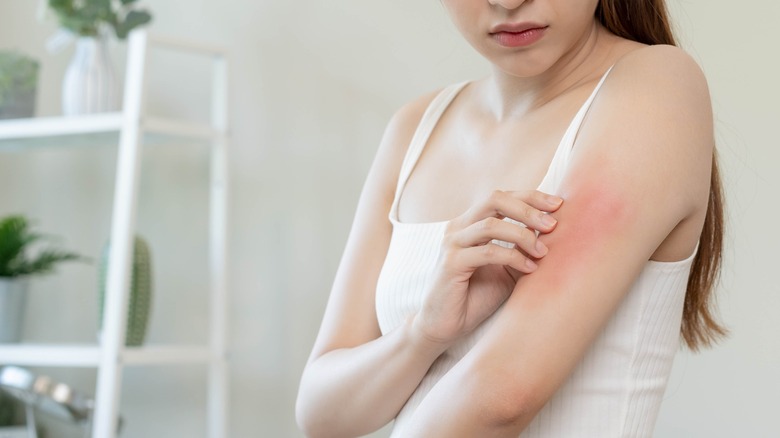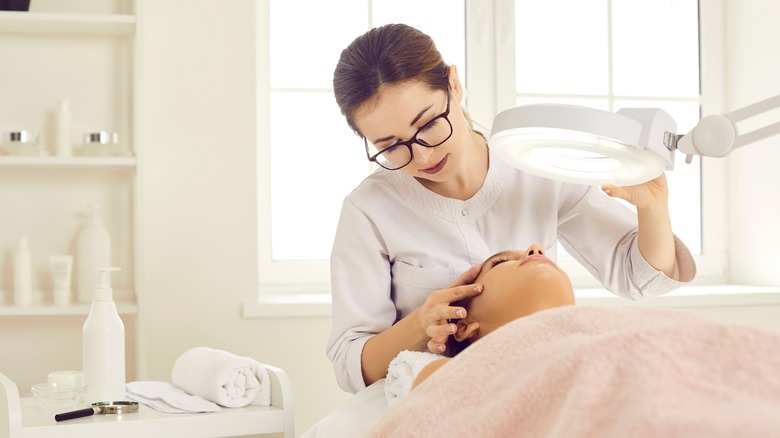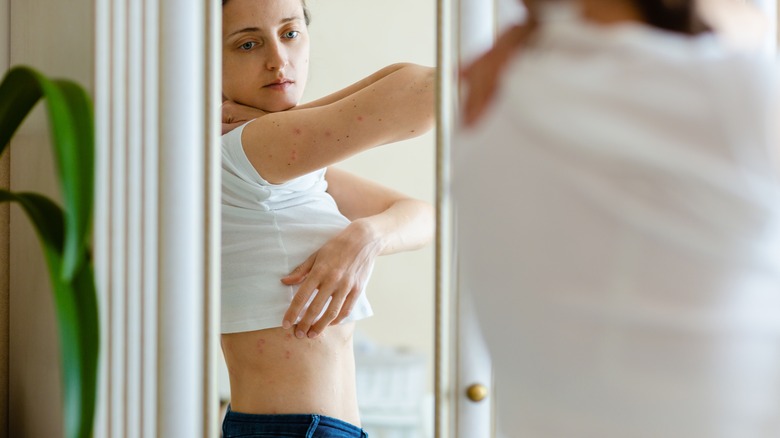The Healing Stages Of Cellulitis Explained
The human skin is home to a diverse community of microorganisms, including bacteria, viruses, and fungi. These are collectively known as the skin microbiome, which plays a crucial role in maintaining the immune and protecting the body from harmful pathogens (via WebMD).
According to a 2021 study published in the journal Microorganisms, the skin microbiome varies from person to person, depending on factors such as sex, health, and age. Some of the most common bacterial species found on the skin include staphylococcus, streptococcus, corynebacterium, cutibacterium acnes, and acinetobacter, per the study.
The study also notes that not all bacteria on the skin are harmful. Many are commensal or even beneficial, meaning that they coexist with the host and provide some form of benefit. For example, some skin bacteria produce antimicrobial compounds that can inhibit the growth of pathogenic bacteria. Others contribute to the skin's natural moisturizing and barrier functions or help modulate the immune system. However, certain types of bacteria can also cause skin infections and other diseases like cellulitis.
What is cellulitis?
Cellulitis is a bacterial infection that affects the skin and underlying tissues (via Mayo Clinic). It can occur anywhere on the body, but most commonly affects the lower legs, arms, and face. Cellulitis happens when bacteria enter the skin through a break or crack, such as a cut, scratch, or surgical wound. The most common bacteria responsible for cellulitis are streptococcus and staphylococcus, which are normally present on the skin. However, these microorganisms can cause infection when they enter deeper tissues. Inadequate personal hygiene can increase the risk of developing cellulitis, as does pre-existing skin conditions such as eczema, explains Cleveland Clinic.
Symptoms of cellulitis include warmth, swelling of the affected area, pain or tenderness, and fever or chills. If left untreated, cellulitis can lead to serious complications such as abscesses, and sepsis (a life-threatening infection that spreads throughout the body), says Healthline. If you experience these symptoms, you should see a doctor immediately for diagnosis.
Diagnosis of cellulitis
It is important to seek medical attention promptly if you suspect that you have cellulitis. Early diagnosis and treatment can help prevent the infection from spreading and reduce the risk of complications. A healthcare provider typically makes the diagnosis of cellulitis based on a physical exam. During the exam, the healthcare provider will look for signs of inflammation, such as redness, warmth, swelling, and tenderness, in the affected area, per the National Institute of Health and Care Excellence (NICE). They may also look for signs of an infection, such as fever, chills, and swollen lymph nodes.
Blood tests, such as a white blood cell count, can also help detect signs of infection in the body. Suppose there is an open wound at the site of the infection. In that case, the healthcare provider may take a sample of the skin tissue and send it to a laboratory for testing to identify the type of bacteria causing the infection.
What are the treatment options for cellulitis?
Cellulitis requires prompt treatment to prevent the infection from spreading and causing complications. Treatment of cellulitis typically involves antibiotics and supportive measures. In most cases, oral antibiotics can be used to treat mild to moderate cases of cellulitis, says the Mayo Clinic. However, people with severe or rapidly spreading cellulitis may require hospitalization for close monitoring and treatment — more severe cases may also require intravenous (IV) antibiotics in a hospital setting, explains the clinic.
Following your doctor's instructions for taking antibiotics is important. You should take the full course of antibiotics, even if you start to feel better before the medication is finished. Failure to take the full course of antibiotics may increase the risk of recurrence or the development of antibiotic-resistant bacteria.
Supportive measures can also help manage symptoms and promote healing. These may include elevating the affected area, applying warm compresses, and taking over-the-counter pain relievers.
What are the healing stages of cellulitis?
The onset of cellulitis occurs when the bacteria first enter the skin and begin to multiply. The various symptoms characterize this stage. The time frame for symptoms to appear might depend on the type of bacteria causing the infection. According to Nemours Teens Health, people with cellulitis caused by pasteurella multocida may experience symptoms within 24 hours. During this stage, the body's immune system works to fight off the infection.
Antibiotics may be prescribed to help speed up the healing process. According to the National Health Services (NHS), symptoms may worsen within 48 hours of starting treatment. The recovery stage of cellulitis is the final stage of healing, during which the body fully recovers from the infection. Recovery should be made within seven to 10 days, depending on the severity of the infection, says the NHS. Hospitalization and intravenous (IV) antibiotics may be required if symptoms continue, says Cleveland Clinic.
Tips to prevent cellulitis from reoccurring
Maintaining a healthy skin microbiome prevents infections and other skin disorders. Good hygiene practices, such as regular hand washing and wearing clean clothes. can help keep the skin clean and minimize the risk of infection, explains the Cleveland Clinic. However, note that excessive use of antibacterial products can disrupt the skin microbiome. This can lead to imbalances or overgrowth of pathogenic bacteria (via WebMD). Therefore, it is recommended to use gentle skin care products and to avoid over-cleansing or over-sanitizing the skin.
According to Cleveland Clinic, some individuals are more susceptible to developing cellulitis than others. These individuals may need to take special care. For example, people with eczema or weakened immune systems have a much higher risk of developing the condition, says the clinic. In such cases, it's best to consult a doctor or dermatologist. They can help you devise effective preventative measures.






